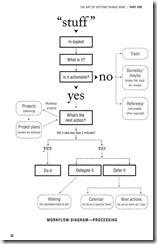At any given time, we all have many things to do. We cannot do them all at once, so we must prioritize them. And we must keep track of them. Most of us keep track in our minds, which forces us to spend mental energy on something other than actually performing these actions.
In his book Getting Things Done, David Allen provides a system for organizing what need to do and accomplishing more. Allen's "GTD" methodology focuses on productivity and remove stress by focusing on things that are important and accomplishing those tasks.
His technique is straightforward.
Distinguish between projects and actions. Projects consist of a list of actions. We perform actions; not projects we perform actions, so identify the actions necessary to complete each project - particularly the very next action you need to perform.
Record these projects and actions in a safe place that you can refer to often. This may be paper or computer files or a software application. This gives you a way to always know what you should be working on and frees you from stressing about them.
Most people keep their list of action items in their head or in an amorphous storage mixed in with other things. This adds unnecessary mental work every time we look at the list.
Allen advocates keeping a "Mind like water", meaning we should focus exclusively on the task at hand.
Allen focuses more on the individual actions in our lives than on long- and medium-term goals; but he does advocate documenting these, as they drive our projects and our actions. A periodic review of our projects and goals is important to ensure we are staying on track.
Here is a key diagram presented in the book to assist you while going through your inbox and determining how to handle each item.
This was my second reading of David Allen's "Getting Things Done" and my first reading of the current edition, which includes references to some software that can help. Allen tends to favor low-tech approaches, such as recording and organizing with paper, pen, and folders, but he leaves the choice of systems to the reader.
As an obsessive list maker, I was already using many of Allen's techniques, but his process added some clarity to how I should approach my organization.
My life is less stressful in part because of the practices I have adopted from this book.

